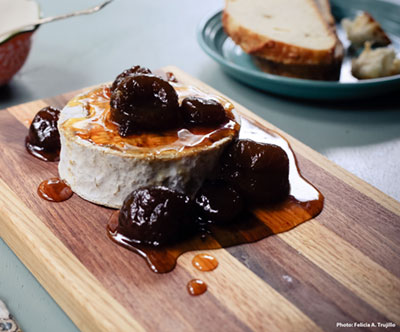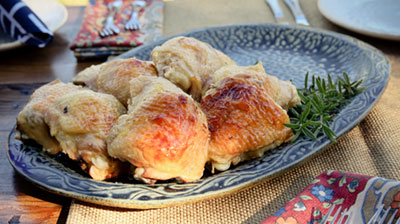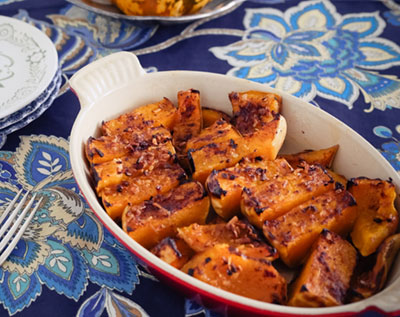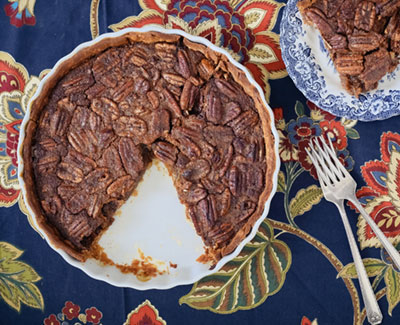
 I remember my first visit to Piedmont, a contemporary Southern restaurant in a renovated warehouse in downtown Durham. It was 2006,its first year of operation, and I was shocked to see the menu include the names of the nearby farms where ingredients were grown and raised. That pig? Hey, he's my neighbor!
I remember my first visit to Piedmont, a contemporary Southern restaurant in a renovated warehouse in downtown Durham. It was 2006,its first year of operation, and I was shocked to see the menu include the names of the nearby farms where ingredients were grown and raised. That pig? Hey, he's my neighbor!
As it would turn out, the pioneering eatery was among the first farm-to-fork establishments in the Bull City. Today, Triangle residents seeking sustainable, local ingredients are commonplace; at Piedmont they continue to savor the excellent result of using heirloom produce, just-laid eggs and pasture-raised animals.
 Much of that bounty originates at the 55-acre Coon Rock Farm, located down the road in Hillsborough. Jamie DeMent owns both Piedmont and Coon Rock with her partner, Richard Holcomb. And now she's written her first cookbook, "The Farmhouse Chef: Recipes & Stories From My Carolina Farm," recently published by The University of North Carolina Press.
Much of that bounty originates at the 55-acre Coon Rock Farm, located down the road in Hillsborough. Jamie DeMent owns both Piedmont and Coon Rock with her partner, Richard Holcomb. And now she's written her first cookbook, "The Farmhouse Chef: Recipes & Stories From My Carolina Farm," recently published by The University of North Carolina Press.
Here are her recipes for a fall dinner fresh off the land.
 Honeyed Figs
Honeyed Figs
You could smear this on cardboard, and it would taste divine. But spread it on biscuits with salted butter for breakfast, add it as a secret ingredient in your turkey sandwich at lunch, or dump a whole jar on a wheel of brie before dinner and bake until it all oozes together. You'll love every bite and come back for more.
5 pounds figs, stemmed
3 cups water, plus more for boiling
1 cup honey
1/2 cup sugar
1 tablespoon fresh lemon juice
per pint jar
Sterilize the jars and lids.
In a small stockpot, cover the figs with water by about 2 inches and bring them to a boil.
Turn the heat down and simmer for 2 minutes to soften the fruit. Drain the water away, and set the figs aside.
Combine the 3 cups of water, honey and sugar in the pot, and bring it to a boil. Stir to dissolve the sugar and keep it from sticking. Add the figs and gently boil them in the syrup for 5–10 minutes – until the syrup starts to thicken.
Line up the hot sterilized jars. Put 1 tablespoon of lemon juice into each jar. Use a slotted spoon to carefully transfer the figs from the syrup pot to the jars. Evenly distribute the figs between the jars, packing them in gently but firmly.
Ladle the hot syrup over the figs to completely cover them. Leave 1/2 inch of headspace between the top of the liquid and the lid. Screw the lids on the jars temporarily.
Gently swirl each jar to release trapped air bubbles. Remove the lids and add syrup, if necessary, to achieve the proper headspace. Put the lids on the jars a final time and seal them tightly. If canning, start your water bath process. If refrigerating, let the jars cool overnight, then transfer them to your refrigerator.
Makes 4 (1-pint) jars
 Buttermilk Roasted Chicken
Buttermilk Roasted Chicken
This recipe is the happy result of a late afternoon meltdown. I had planned to cook fried chicken for a crowd at the farm and, as often happens, the day ran away with me. Pigs got loose and tore up a freshly planted bed. I spent the afternoon replanting instead of getting ready to feed people. The prospect of dredging and dealing with scalding hot lard brought me nearly to tears, so I grabbed the marinated chicken, stuck it in the oven, and hoped for the best. The results were so juicy and delicious that I started playing with ingredients and added this final recipe to our regular rotation. Chicken breasts (bone-in, skin-on) can be substituted for this recipe, but be sure to cut the cooking time by 5 minutes for each segment.
2 pounds skin-on chicken thighs and/or legs
2 cups cultured buttermilk
1/4 cup plus 2 tablespoons olive oil
2 garlic cloves, roughly minced
2 tablespoons roughly chopped fresh rosemary leaves
2 tablespoons roughly chopped fresh oregano
1 tablespoon sorghum
Salt and freshly ground black pepper, to taste
Juice of 1 lime
1/2 cup roughly chopped fresh parsley
Place the chicken in a large, sealable freezer bag. Add the buttermilk, 1/4 cup of the oil, and the garlic, herbs, sorghum, salt and pepper. Seal the bag and refrigerate overnight.
When you're ready to cook the chicken, preheat the oven to 400 degrees.
Remove the chicken from the marinade and shake off any excess. Drizzle the bottom of an oven-safe roasting pan or cast-iron skillet with the remaining 2 tablespoons oil and arrange the chicken around the pan.
Roast the chicken, uncovered, for 30 minutes at 400 degrees. Turn the heat down to 325 degrees and continue roasting until the chicken is well browned and juices run clear when the chicken is pierced through the thickest part of the meat (about 20 more minutes).
When the chicken is done, take it out of the oven and let it rest out of the pan for 10 minutes before serving. For serving, drizzle the pan juices and juice from the lime over the chicken and scatter chopped parsley on top.
Makes 4-6 servings
 Roasted Butternut Squash With Cinnamon Butter and Shallots
Roasted Butternut Squash With Cinnamon Butter and Shallots
Fall squash, such as pumpkins, acorn squash and butternuts, are storage crops, so they keep at room temperature for months. They're usually pretty, so I sit them around as decoration until I want to use one. Leftovers can be puréed and added to chicken stock for soup or diced up and served cold as a salad ingredient. This recipe offers a very basic way to cook butternuts. Feel free to add all kinds of herbs and flavorings to make it your own.
1 butternut squash
1 teaspoon olive oil
1 large shallot, finely chopped
4 tablespoons unsalted butter, melted
1/4 teaspoon ground cinnamon
Sea salt and freshly ground black pepper, to taste
Preheat the oven to 400 degrees.
Spread the olive oil evenly on the bottom of the baking sheet. Use a sharp knife to slice off the ends of the butternut squash and then slice the squash in half. With a spoon, scoop out the seeds (save them for roasting later). Slice the squash in 1-inch-thick slices, and arrange them with the skin side down on the oiled baking sheet.
Sprinkle the shallots on top of the butternut squash. Drizzle the melted butter over the squash and shallots. Finally, sprinkle cinnamon, salt and pepper over everything, and toss it all to coat, making sure again that the squash ends up skin side down.
Place the pan in the oven and roast for 20 minutes. Flip the slices to ensure even baking.
Put the pan back in the oven to continue baking for 10-20 more minutes. The squash is done when it's fork-tender. Remove from the oven and serve.
Makes 4 – 6 servings
 Cane Syrup Pecan Pie
Cane Syrup Pecan Pie
Some people say that I live in the superlative. Everything is the very best or very worst. Well, this is the best pecan pie you will ever cook. I promise. No corn syrup needed. People from around the world will sit at your dinner table and tell you how brilliant you are. You will win Thanksgiving every year. Peace on earth will descend around you. All because of some pecans and some old-time cane syrup.
1 unbaked pie crust
4 tablespoons unsalted butter
1 tablespoon all-purpose flour
1 tablespoon cornstarch
1 1/2 cups pure cane syrup
1/2 cup sugar
2 large eggs
1/4 teaspoon salt
1 cup pecan halves
1 teaspoon pure vanilla extract
1 tablespoon bourbon
Preheat the oven to 450 degrees. Line a 9-inch pie pan with the pie crust.
In a medium-sized saucepan, melt the butter and stir in the flour and cornstarch until smooth. Add the cane syrup and sugar, and boil for 3 minutes. Remove from the heat and cool.
In a separate small bowl, beat 2 eggs. Add the eggs and the rest of the ingredients to the pot, and stir them to mix well. Pour everything into your pie crust and lightly tap it on the counter to even out the nuts and release any air bubbles.
Place the pie in the oven and bake at 450 degrees for 10 minutes. Turn the heat down to 350 degrees and bake for an additional 30-35 minutes–until the pie is done and not jiggly in the center.
Remove the pie from the oven and allow it to cool a little before serving.
Makes 6 – 8 servings
All recipes from "The Farmhouse Chef: Recipes and Stories From My Carolina Farm" by Jamie DeMent. Copyright © 2017 by Jamie DeMent. Used by permission of the University of North Carolina Press. www.uncpress.org